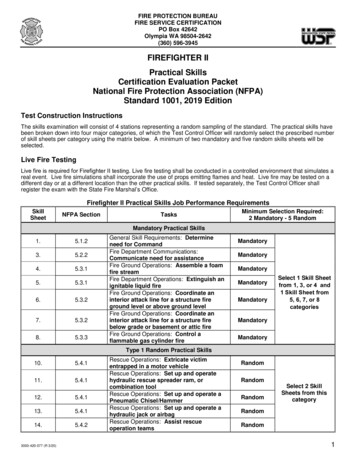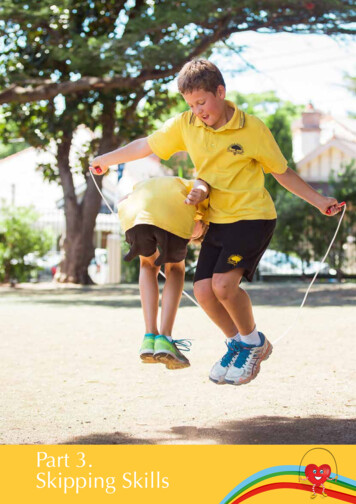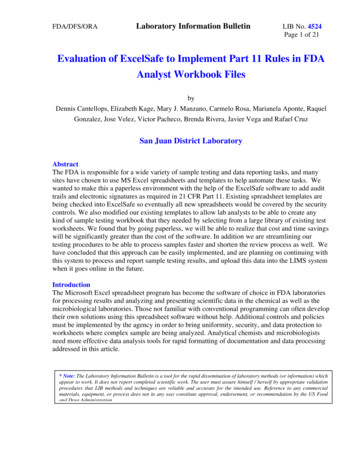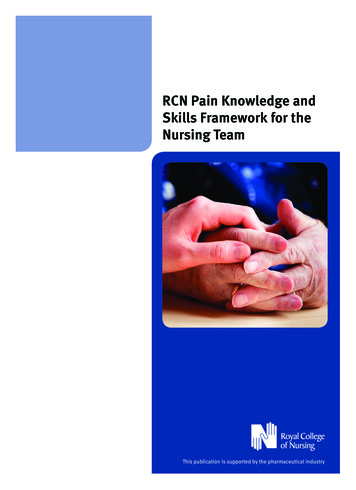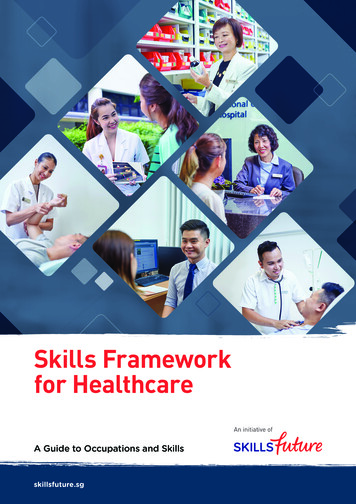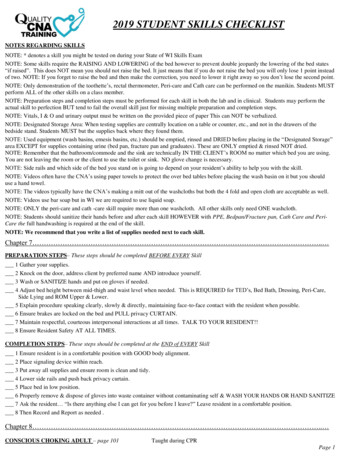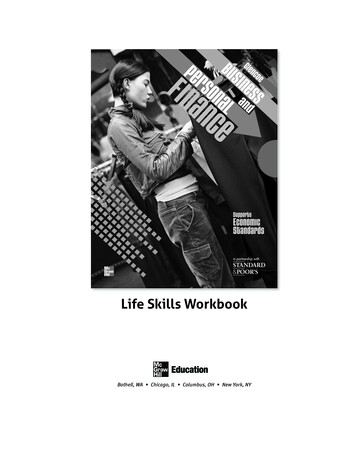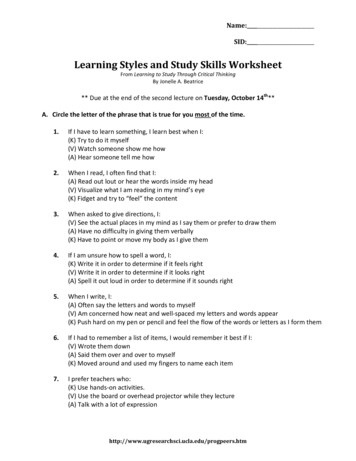
Transcription
9/22/2015Evaluation Skills Part 1:TorticollisSamantha Arritt, PT, DPTObjectives: To define what torticollis isTo identify 6 types of torticollisTo evaluate torticollis using SOAP formatTo apply the PIQ tool when assessingtorticollis To identify 4 treatment techniques fortorticollisPIQ Posture in Positions Initiation and Inhibition Quality and Quantity1
9/22/2015PIQSupineProneSittingStanding Quadruped KneelingPosture inPositionsInitiatesCan't DoQualityPosture in Positions What are they doing in:– Supine– Prone– Sitting– Standing– Quadruped– KneelingInitiation and Inhibition Observe what movements the child initiates What functional movements can they do– Can they feed themselves? Rotate to reach forobjects? What parts of their body are they using for themovements? What is inhibiting them from initiating othermovements? Are they stuck in one position? Isthis a primitive reflex? Can they sustain and terminate movements? What transitions do they initiate?2
9/22/2015Quality and Quantity How do they initiate the movements (body part flexion,extension, dissociation)? Where is the head in relation to the body duringtransitions? Are they using one side of their body more than another? Are they using mass patterns of flexion or extension? What is the speed of their movements? Are they using a more immature pattern of movement? Is there any change in respiratory pattern?Torticollis Torticollis ("twistedneck"); Plagiocephaly("oblique head") Back-to-sleepprogram started in1992, with 40%decrease in SIDS andincrease in posteriorplagiocephaly andtorticollis1Torticollis Causes:– May be related to: Intrauterine malpositioning Ischemic event and compartment syndrome Birth trauma3
9/22/2015Torticollis Prone positioning for 1 hour and 21minutes a day when awake for 4 montholds significant differences in milestoneachievement2– hands and knees– active extension– sitting skill progression– prone positioning helps with other anti-gravityand weight bearing skillsTorticollis associated with:1. Benign Paroxysmal Torticollis2. Plagiocephaly without synostosis (PWS)3. Plagiocephaly with synostosis4. Vertebral anomalies5. Ocular torticollis6. Idiopathic Muscular Torticollis (congenital)Benign Paroxysmal Torticollis When a child presents with a different tilteach visit Look for:– a family history of vestibular problems– a family history of migraines– on medication REGLAN (for severe GERD)4
9/22/2015Plagiocephaly without Synostosis AKA: Postural torticollisOnset is immediately after birthNo fibrotic changes in muscleRelated to preferred sleeping positionEasily treated with passive musclestretching and re-positioning program ifcaught earlyPlagiocephaly with Synostosis Early closure of sutures of the skull(normally between 12-18 months)– Increased ICP– Vision, hearing, and breathing problems Head shaped like a trapezoid Ear positioned posteriorly Smaller vertical length of face andhorizontal length may be larger Requires surgeryDeformational Plagiocephaly vsPlagiocephaly with Synostosis5
9/22/2015Vertebral Anomalies Klippel-Feil anomaly (bony anomaly)– Fusion of any 2 of the 7 cervical vertebrae– Failure of division of cervical vertebrae during earlyfetal development– Leads to scoliosis and head tilt– Identified by cervical spine x-rays– Associated defects: anomalies of kidneys, ribs, cleftpalate, respiratory problems, heart malformationKlippel-Feil AnomalyOcular Torticollis Most commonly paresis of superior oblique (turns eyedown and out) innervated by cranial nerve 4 (trochlear) May also be CN 3 (oculomotor) Persistent head tilt resulting in secondary neckcontractures Not likely before 6 months of age Sit up test:– Look at degree of torticollis in supine and sitting– If torticollis resolves in supine, it's ocular torticollis6
9/22/2015Idiopathic Muscular Torticollis Congenital Cause: fetal position, birth trauma,vascular injury to SCM See plagiocephaly with it- need to treatboth See 1-2 weeks after birth Some muscular fibrosis: either tumorousor bands Trapezius muscle may be affectedSCM AnatomyIdiopathic Muscular Torticollis Risk factors for infants 7-12 weeks old3:– Sleeping in supine: 2.7x odds of gettingposterior plagiocephaly– Males were 1.5x more likely to get posteriorplagiocephaly– If they have a right sided or left sided headpositional preference, this is a 4x the odds ofdeveloping posterior plagiocephaly– Most are right sided preference7
9/22/2015Impact of Torticollis Altered perception of center of massAsymmetrical weight bearingTransitions affected by neck asymmetryProtective extension reactions may bedelayed Compensations diminish development ofmidline postural control4Before Treatment Decide origin of torticollis– 18% are non-muscular Do not start a stretching program until acervical spine x-ray is performed5* *limited value of xrays in infantsEvaluating Torticollis SOAP format PIQ tool8
9/22/2015Subjective (S) Birth history– Pre or peri natal difficulties– Ultrasounds show restriction of space Family history Medical history– Reflux Sandifer's Syndrome– Neurological issues– X-rays of cervical spine– Passed hearing and vision screening Typical day– How much time spent in "containment devices"Objective (O) PIQ– Posture in Positions Face in midline in supine Describe flat spots, plagio- vs scapho- vs brachycephaly– Palpate neck (tight band?)– Palpate along sutures to check for ridging (wantsutures open)– Cranial Vault Asymmetry IndexBrachycephaly vs Plagiocephaly vsScaphocephaly9
9/22/2015Objective (O) Head righting reactions– full, partial, or no response Range of motion– Measure active and passive to both sides neck rotation (100-120 degrees) lateral flexion ( 65 degrees)Objective (O) Muscle Function Scale (MFS) for infants6– Hold infant vertically around trunk without support ofhead, then lower to horizontal position; have grid ofhorizontal lines behind; has to hold head for 5seconds to get score– Rating scale of 0-4 0 head below horizontal1 head in the horizontal2 head slightly over horizontal3 head high over horizontal4 head very high over horizontalObjective (O) Initiation and inhibition– Look at anti- and pro- gravity movements– Describe their movement patterns Asymmetrical neck extension to the side of tightness– What can they NOT do? Head righting reactionsProtective reactions (delayed on opposite side of tilt)Head control in various positionsDifficulty reaching with upper extremitiesPoor or asymmetrical upper extremity weight bearing inprone 2 handed play, hand transfer skills, grasping10
9/22/2015Objective (O) Quality and quantity– How are they rolling? Lateral neck flexion at sidelying phase to bothsides– How are they reaching for toys in prone?Objective (O) Sensation and perception– Visual tracking (peripheral and central)– Decreased visual engagement– Delayed visual convergence– Difficulty with downward gaze– Response to auditory input– Response to tactile inputPlan (P) Goals:– Neutral head position– Full passive and active ROM into restrictedareas– Correct movement patterns for ageappropriate movements (head righting duringrolling)– Prevent facial and skull deformities– Prevent postural changes11
9/22/2015Plan (P) Treatment algorithm for Muscular Torticollis 71. PT 6-8 weeks then re-evaluate Improving: continue PT 6-8 more weeks Not improving: ophthalmological and neurological evaluation Persistent head tilt with tight band: consider surgery at 2-3 years2. Persistent head tilt with negative medical workup and unclearexam, check for: C spine x-rays C spine CT Brain and C spine MRI– Most cases resolve within an average of 6 months– 90-99% resolve with conservative treatmentTreatment Massage Stretching of tight muscles (neck and trunk)– Contraindications: Down Syndrome/ ligament laxity;Spina Bifida; Bony abnormalities; Compromisedcirculatory or respiratory system Strengthening of weak musclesActive positioningUse of correct patterns for movementAddress deficits in developmental progressionReferral for helmet? or Surgery?Treatment Stretching– Lengthen anterior neck muscles (hand in V over sternum andchild looks up- platysma)– Left and right rotation– Left and right lateral neck flexion– Suboccipital release Strengthening– Active lateral neck flexion ("active carrying")– Sidelying- lifting head against gravity– Righting reactions Range of motion– Active and passive neck rotation– Active and passive lateral neck flexion– Active and passive neck flexion and extension12
9/22/2015TreatmentTreatment Kinesiotape:1.Tape to facilitate SCM and upper trapezius onthe weak side with no stretch to the tape2.Muscle-relaxing on affected side (across SCMwith mild stretch)8*3.Combination of both *study found muscle-relaxing technique was themost effective, but should be used with otherinterventionsTreatment13
9/22/2015Treatment Tortle– Good for younger,less active babies The Lounger– Positions child in aflexed position withhead in midlineTreatment Helmet– Based on literature, themost effective period forcranial remodeling is 4-12months– Cranial remodeling in veryyoung infants, birth to 5months, can be influencedby re-positioning andhandling– The FDA prohibits thedispensing of helmets forcranial remolding after 18months of ageTreatment Helmet– Better outcome for helmet treatment vsnatural course– Infant with helmets reached much betteroutcome within a shorter time– Helmet reduced initial asymmetry by 68%;non helmet reduced by 31%914
9/22/2015Treatment Helmet– Children over 12 months treated with helmettherapy had an improvement in skull shape inthe same interval as younger infants10– Supports the use of helmets with children upto the age of 18 months of ageHEP HEP!!!!!!–––––––––90 minutes/week of PT vs 166 hours at homeStretchingPositioning (prone)Visual trackingCarrying to activate weak muscles (facilitate headrighting)Active cervical rotation in supine and proneActive cervical rotation with reaching in supineOverhead reaching to get UE stretchingROLE: right on odd days, left on even daysHEP Protocols Exercises repeated throughout the day for5x/day (or at every diaper change) Each stretch held for 30 seconds astolerated Stretches done 4-5x/day (or at everydiaper change) *Continue up to 3 months afterdischarge*1115
9/22/2015HEP Evidence Protocol12:– PTs doing stretching vs parents doingstretching PTs: 3x/week; stretch from 10-30 seconds; eachsession about 15 minutes (parents did nostretching at home) Parents: 3-5 short sessions, 2x/day; held stretch10-30 seconds; lasted 15 minutes; did 7days/weekHEP Evidence cont. Outcome:– All achieved good ROM but PT groupachieved that ROM faster– PT achieved ROM within 0.9 months vs 3months for parent group– "No head tilt" reached faster for PT group (2.5months) vs 4.5 months for parent group– At first evaluation, 18 infants hadplagiocephaly but only 2 had it after treatmentResource for Families Video: www.HeadsUpBaby.com– "Heads Up Baby: Prevention and earlytreatment of deformational plagiocephalyin your baby" What is plagiocephaly: risk factors, prevention,treatment Altering home environment and re-positioning Tummy time and sitting activities Strengthening and stretching activities16
9/22/2015Resources Karen Karmel-Ross book: TORTICOLLIS On-line sources for pictures of stretches– Texas Pediatric Surgical Associate www.pedisurg.com/PtEduc/Torticollis.htm– www.orthoseek.com/articles/ifs-left.html– www.torticolliskids.org/favorite.htm– www.cranialtech.comReferences All information written and presented by: Michelle Linehan MSPT,PCS,M.EdImages: from google1: Kinney HC, Thach, BT (2009)2: Dudek,L,Zelany,S (2007) The effects of prone positioning of the quality and acquisition ofdevelopmental milestones in four-month-old-infants. Pediatric Physical Therapy, 19, 48-553: Mawji,et al (2014)4: Oledzka,et al (2013 APTA CSM) Clinical Approach to the Evaluation and Treatment ofCongenital Muscular Torticollis5: Synder, EM, Coley, BD (2006) Limited value of plain radiographs in infant torticollis. Pediatrics,118 (6),e1179-846: Ohman, et al (2008)7: from presentation at APTA Combined Sections Meeting, Jan 2013; Magada Oledzka, PT, MBA,PCS; Maureen Suht PT, DPT, PCS; Roger Widmann, MD8: Ohman (2012)9: Kluba, et al (2014)10: Couture DE, et al (2013)11: From presentation at APTA Combined Sections Meeting, Jan 2013; Magda Oledzka, PT, MBA,PCS; Maureen Suht, PT, DPT, PCS; Roger Widmann, MD12: Ohman, et al (2010)17
Sit up test: – Look at degree of torticollis in supine and sitting – If torticollis resolves in supine, it's ocular torticollis. 9/22/2015 7 Idiopathic Muscular Torticollis Congenital Cause: fetal position, birth trauma, vascular
